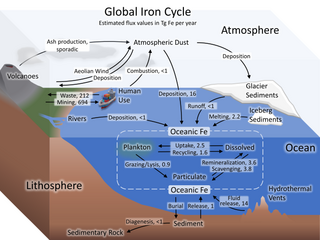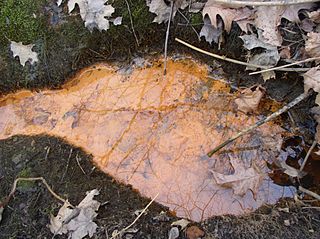Related Research Articles

The nitrogen cycle is the biogeochemical cycle by which nitrogen is converted into multiple chemical forms as it circulates among atmospheric, terrestrial, and marine ecosystems. The conversion of nitrogen can be carried out through both biological and physical processes. Important processes in the nitrogen cycle include fixation, ammonification, nitrification, and denitrification. The majority of Earth's atmosphere (78%) is atmospheric nitrogen, making it the largest source of nitrogen. However, atmospheric nitrogen has limited availability for biological use, leading to a scarcity of usable nitrogen in many types of ecosystems.

Goethite is a mineral of the diaspore group, consisting of iron(III) oxide-hydroxide, specifically the α-polymorph. It is found in soil and other low-temperature environments such as sediment. Goethite has been well known since ancient times for its use as a pigment. Evidence has been found of its use in paint pigment samples taken from the caves of Lascaux in France. It was first described in 1806 based on samples found in the Hollertszug Mine in Herdorf, Germany. The mineral was named after the German polymath and poet Johann Wolfgang von Goethe (1749–1832).
In organochlorine chemistry, reductive dechlorination describes any chemical reaction which cleaves the covalent bond between carbon and chlorine via reductants, to release chloride ions. Many modalities have been implemented, depending on the application. Reductive dechlorination is often applied to remediation of chlorinated pesticides or dry cleaning solvents. It is also used occasionally in the synthesis of organic compounds, e.g. as pharmaceuticals.

The iron cycle (Fe) is the biogeochemical cycle of iron through the atmosphere, hydrosphere, biosphere and lithosphere. While Fe is highly abundant in the Earth's crust, it is less common in oxygenated surface waters. Iron is a key micronutrient in primary productivity, and a limiting nutrient in the Southern ocean, eastern equatorial Pacific, and the subarctic Pacific referred to as High-Nutrient, Low-Chlorophyll (HNLC) regions of the ocean.

In oceanography and limnology, the sediment–water interface is the boundary between bed sediment and the overlying water column. The term usually refers to a thin layer of water at the very surface of sediments on the seafloor. In the ocean, estuaries, and lakes, this layer interacts with the water above it through physical flow and chemical reactions mediated by the micro-organisms, animals, and plants living at the bottom of the water body. The topography of this interface is often dynamic, as it is affected by physical processes and biological processes. Physical, biological, and chemical processes occur at the sediment-water interface as a result of a number of gradients such as chemical potential gradients, pore water gradients, and oxygen gradients.

Iron-oxidizing bacteria are chemotrophic bacteria that derive energy by oxidizing dissolved iron. They are known to grow and proliferate in waters containing iron concentrations as low as 0.1 mg/L. However, at least 0.3 ppm of dissolved oxygen is needed to carry out the oxidation.
Denitrifying bacteria are a diverse group of bacteria that encompass many different phyla. This group of bacteria, together with denitrifying fungi and archaea, is capable of performing denitrification as part of the nitrogen cycle. Denitrification is performed by a variety of denitrifying bacteria that are widely distributed in soils and sediments and that use oxidized nitrogen compounds in absence of oxygen as a terminal electron acceptor. They metabolise nitrogenous compounds using various enzymes, turning nitrogen oxides back to nitrogen gas or nitrous oxide.
Submarine groundwater discharge (SGD) is a hydrological process which commonly occurs in coastal areas. It is described as submarine inflow of fresh-, and brackish groundwater from land into the sea. Submarine Groundwater Discharge is controlled by several forcing mechanisms, which cause a hydraulic gradient between land and sea. Considering the different regional settings the discharge occurs either as (1) a focused flow along fractures in karst and rocky areas, (2) a dispersed flow in soft sediments, or (3) a recirculation of seawater within marine sediments. Submarine Groundwater Discharge plays an important role in coastal biogeochemical processes and hydrological cycles such as the formation of offshore plankton blooms, hydrological cycles, and the release of nutrients, trace elements and gases. It affects coastal ecosystems and has been used as a freshwater resource by some local communities for millennia.

The phosphorus cycle is the biogeochemical cycle that describes the movement of phosphorus through the lithosphere, hydrosphere, and biosphere. Unlike many other biogeochemical cycles, the atmosphere does not play a significant role in the movement of phosphorus, because phosphorus and phosphorus-based compounds are usually solids at the typical ranges of temperature and pressure found on Earth. The production of phosphine gas occurs in only specialized, local conditions. Therefore, the phosphorus cycle should be viewed from whole Earth system and then specifically focused on the cycle in terrestrial and aquatic systems.

Gammaproteobacteria is a class of bacteria in the phylum Pseudomonadota. It contains about 250 genera, which makes it the most genus-rich taxon of the Prokaryotes. Several medically, ecologically, and scientifically important groups of bacteria belong to this class. It is composed by all Gram-negative microbes and is the most phylogenetically and physiologically diverse class of Proteobacteria.

A redox gradient is a series of reduction-oxidation (redox) reactions sorted according to redox potential. The redox ladder displays the order in which redox reactions occur based on the free energy gained from redox pairs. These redox gradients form both spatially and temporally as a result of differences in microbial processes, chemical composition of the environment, and oxidative potential. Common environments where redox gradients exist are coastal marshes, lakes, contaminant plumes, and soils.
Crocetane, or 2,6,11,15-tetramethylhexadecane, is an isoprenoid hydrocarbon compound. Unlike its isomer phytane, crocetane has a tail-to-tail linked isoprenoid skeleton. Crocetane has been detected in modern sediments and geological records as a biomarker, often associated with anaerobic methane oxidation.

Marine biogeochemical cycles are biogeochemical cycles that occur within marine environments, that is, in the saltwater of seas or oceans or the brackish water of coastal estuaries. These biogeochemical cycles are the pathways chemical substances and elements move through within the marine environment. In addition, substances and elements can be imported into or exported from the marine environment. These imports and exports can occur as exchanges with the atmosphere above, the ocean floor below, or as runoff from the land.

Cable bacteria are filamentous bacteria that conduct electricity across distances over 1 cm in sediment and groundwater aquifers. Cable bacteria allow for long-distance electron transport, which connects electron donors to electron acceptors, connecting previously separated oxidation and reduction reactions. Cable bacteria couple the reduction of oxygen or nitrate at the sediment's surface to the oxidation of sulfide in the deeper, anoxic, sediment layers.

Microbial oxidation of sulfur is the oxidation of sulfur by microorganisms to build their structural components. The oxidation of inorganic compounds is the strategy primarily used by chemolithotrophic microorganisms to obtain energy to survive, grow and reproduce. Some inorganic forms of reduced sulfur, mainly sulfide (H2S/HS−) and elemental sulfur (S0), can be oxidized by chemolithotrophic sulfur-oxidizing prokaryotes, usually coupled to the reduction of oxygen (O2) or nitrate (NO3−). Anaerobic sulfur oxidizers include photolithoautotrophs that obtain their energy from sunlight, hydrogen from sulfide, and carbon from carbon dioxide (CO2).
Caroline Masiello is a biogeochemist who develops tools to better understand the cycling and fate of globally relevant elemental cycles. She is a professor at Rice University in the Department of Earth, Environmental and Planetary Sciences and holds joint appointments in the Chemistry and Biochemistry Departments. Masiello was elected as a Fellow of the Geological Society of America in 2017. She currently leads an interdisciplinary team of scientists who are developing microbial sensors for earth system science.

Saharan dust is an aeolian mineral dust from the Sahara desert, the largest hot desert in the world. The desert spans just over 9 million square kilometers, from the Atlantic Ocean to the Red Sea, from the Mediterranean sea to the Niger River valley and the Sudan region in the south.
Clare Reimers is a Distinguished Professor of Ocean Ecology and Biogeochemistry at Oregon State University's College of Earth, Ocean and Atmospheric Sciences.
Elizabeth A. Canuel is a chemical oceanographer known for her work on organic carbon cycling in aquatic environments. She is the Chancellor Professor of Marine Science at the College of William & Mary and is an elected fellow of the Geochemical Society and the European Association of Geochemistry.
Karen Johnson is a British geologist who is a professor in environmental engineering at Durham University. She was awarded the 2023 Royal Society Rosalind Franklin Award.
References
- 1 2 3 4 "Caroline Slomp appointed Professor of Geomicrobiology and Biogeochemistry | Radboud University". www.ru.nl. Retrieved 2022-12-31.
- ↑ "Autobiographical sketches: Caroline Slomp". Oceanography. 27 (4): 221. December 17, 2015.
- ↑ "Prof. Slomp, C.P. (Caroline) | Radboud University". www.ru.nl. Retrieved 2022-12-31.
- ↑ Slomp, Caroline P.; Epping, Eric H. G.; Helder, Willem; Raaphorst, Wim Van (1996-11-01). "A key role for iron-bound phosphorus in authigenic apatite formation in North Atlantic continental platform sediments". Journal of Marine Research. 54 (6): 1179–1205. doi:10.1357/0022240963213745.
- ↑ Slomp, C. P.; Van der Gaast, S. J.; Van Raaphorst, W. (1996-03-01). "Phosphorus binding by poorly crystalline iron oxides in North Sea sediments". Marine Chemistry. 52 (1): 55–73. doi:10.1016/0304-4203(95)00078-X. hdl: 1874/31412 . ISSN 0304-4203. S2CID 97421756.
- ↑ Slomp, Caroline P.; Van Cappellen, Philippe (2004-08-10). "Nutrient inputs to the coastal ocean through submarine groundwater discharge: controls and potential impact". Journal of Hydrology. 295 (1): 64–86. doi:10.1016/j.jhydrol.2004.02.018. hdl: 1874/11282 . ISSN 0022-1694. S2CID 130711252.
- ↑ Slomp, Caroline P; Thomson, John; de Lange, Gert J (2004-01-15). "Controls on phosphorus regeneration and burial during formation of eastern Mediterranean sapropels". Marine Geology. 203 (1): 141–159. doi:10.1016/S0025-3227(03)00335-9. hdl: 1874/11283 . ISSN 0025-3227. S2CID 130764276.
- ↑ Egger, Matthias; Rasigraf, Olivia; Sapart, Célia J.; Jilbert, Tom; Jetten, Mike S. M.; Röckmann, Thomas; van der Veen, Carina; Bândă, Narcisa; Kartal, Boran; Ettwig, Katharina F.; Slomp, Caroline P. (2015-01-06). "Iron-Mediated Anaerobic Oxidation of Methane in Brackish Coastal Sediments". Environmental Science & Technology. 49 (1): 277–283. doi:10.1021/es503663z. hdl: 2066/135831 . ISSN 0013-936X. PMID 25412274. S2CID 206985897.
- ↑ Sulu-Gambari, Fatimah; Seitaj, Dorina; Meysman, Filip J. R.; Schauer, Regina; Polerecky, Lubos; Slomp, Caroline P. (2016-02-02). "Cable Bacteria Control Iron–Phosphorus Dynamics in Sediments of a Coastal Hypoxic Basin". Environmental Science & Technology. 50 (3): 1227–1233. doi:10.1021/acs.est.5b04369. ISSN 0013-936X. PMID 26720721.
- ↑ Hermans, Martijn; Lenstra, Wytze K.; Hidalgo-Martinez, Silvia; van Helmond, Niels A. G. M.; Witbaard, Rob; Meysman, Filip J.R.; Gonzalez, Santiago; Slomp, Caroline P. (2019-05-31). "Abundance and Biogeochemical Impact of Cable Bacteria in Baltic Sea Sediments". Environmental Science & Technology. 53 (13): 7494–7503. doi:10.1021/acs.est.9b01665. ISSN 0013-936X. PMC 6611076 . PMID 31149818.
- ↑ "Anammox bacteria allow wastewater to be used for generating electricity". phys.org. May 19, 2020. Retrieved 2022-12-31.
- ↑ "Current Fellows". www.fysiografen.se. Retrieved 2022-12-31.
- ↑ "P. Gast Lecture | European Association of Geochemistry" . Retrieved 2022-12-31.
- ↑ "Geochemistry Fellows | European Association of Geochemistry" . Retrieved 2022-12-31.
- ↑ Kan-Parker, Mirjam van (2020-02-11). "Professor Caroline Slomp elected Geochemistry Fellow". NESSC. Retrieved 2022-12-31.